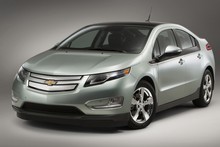Volt EV test fire and result of Hagzhou EV battery explosion

A Chevrolet Volt that caught fire three weeks after it ‘s li-ion battery was damaged in a crash test has caused American regulators to review safety protocols for electric car batteries. The fire comes after the findings of the Hangzhou EV taxi fire investigation. Reports are now being made of fires in other vehicles including Minis.
The car that caught fire was tested on May 12 using a side impact test intended to replicate crashing into a telegraph pole or a tree. Three weeks later, while the car was parked at the test facility, it caught fire and damaged a number of other cars that were parked nearby.
A spokesman for GM said that the test did not follow the procedures developed by GM for handling the Volt after a crash. These procedures had been designed after 300,000 hours of tests, but had apparently not been passed on to the engineers who conducted the government test.
The NHTSA have not yet explained why the Volt’s battery was damaged and intend to conduct more tests over the next few weeks. Both the NHTSA and GM said that they were unaware of any similar fires amon the 5.000 Volts now on the road.
The fire follows the conclusion of the investigation into the Hangzhou taxi fire [ See blog article dated ] that has concluded that the cause of the fire was not a design issue, but rather a failure of the battery pack production process. It seems that after the battery had been in use for a while, battery leakage and insulation damage occurred causing a short – circuit. Battery management systems were identified in a report dated 2010 by Interchinaconsulting.com. The report indicates that China has not invested in fundamental materials research
“For example, China’s best LiFePO4 materials attain a purity of 94%,” the report said. Ideally, the purity level would be less than one millionth. The process used by local suppliers can’t attain that level, said InterChina. Separator films are another weakness—China depends on imports, said the report.√جª¬ø
A seperate report by Interchina concluded that production problems are occuring due to the growth a small companies relying on cheap equipment and cost cutting to keep prices low. As at 2010 there were 52 rechargeable battery manufacturers in China, with 94 pure electric vehicles approved for production. Interchina conclude that US technology is more advanced and that joint ventures that have been built between companies such as Ener1 of New York and Wangxiang EV of Hangzhou do not always share the IP, but systems control, cooling and other processes.
The findings of the Chinese investigation show slimiarities with the early NHTSA test conclusions. A spokesman for GM said that exposure to weather following a leakage of coolant that crystalised and combined with the remaining charge in the battery may well have been the cause of the fire. This shows that drainage of fuel following a crash is critical and that occupants must be warned to do as they would in a conventional car following an accident, ie get out and move a safe distance away.
Overheating of li-ion batteries is also under consideration, following several recalls of laptop batteries made by Sony Corp for Apple, Dell, Lenovo Group and other PC makers in 2006 and 2007 when it was discovered they could overheat and ignite.
Mini Cooper
It is not only Electric Vehicles that are making the news through engine fires. The Sunday Times 13.11.2011 reported a number of incidents and similar complaints have emerged from the USA. In October, the NHTSA reported that 12 complaints of engine fires to Mini Cooper S had been received, 5 resulting in total loss of the vehicles. It seems that 8 of the complaints indicated that a fire occurred when the vehicles were parked with the ignition turned off.
Originally posted 2011-11-16 00:00:00.


